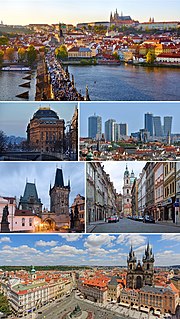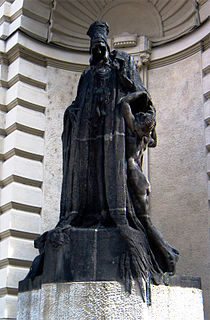
The John Newbery Medal, frequently shortened to the Newbery, is a literary award given by the Association for Library Service to Children (ALSC), a division of the American Library Association (ALA), to the author of "the most distinguished contribution to American literature for children". The Newbery and the Caldecott Medal are considered the two most prestigious awards for children's literature in the United States. Books selected are widely carried by bookstores and libraries, the authors are interviewed on television, and master's and doctoral theses are written on them. Named for John Newbery, an 18th-century English publisher of juvenile books, the winner of the Newbery is selected at the ALA's Midwinter Conference by a fifteen-person committee. The Newbery was proposed by Frederic G. Melcher in 1921, making it the first children's book award in the world. The physical bronze medal was designed by Rene Paul Chambellan and is given to the winning author at the next ALA annual conference. Since its founding there have been several changes to the composition of the selection committee, while the physical medal remains the same.
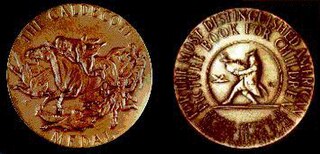
The Randolph Caldecott Medal annually recognizes the preceding year's "most distinguished American picture book for children", beginning with 1937 publications. It is awarded to the illustrator by the Association for Library Service to Children (ALSC), a division of the American Library Association (ALA). The Caldecott and Newbery Medals are the most prestigious American children's book awards.

Kevin Henkes is an American writer and illustrator of children's books. As an illustrator he won the Caldecott Medal for Kitten's First Full Moon (2004). Two of his books were Newbery Medal Honor Books, Olive's Ocean in 2004 and The Year of Billy Miller in 2014. His picture book Waiting was named both a 2016 Caldecott Honor Book and a Geisel Honor Book. It was only the second time any author has won that combination of awards.

David Wiesner is an American illustrator and writer of children's books, known best for picture books including some that tell stories without words. As an illustrator he has won three Caldecott Medals recognizing the year's "most distinguished American picture book for children" and he was one of five finalists in 2008 for the biennial, international Hans Christian Andersen Award, the highest recognition available for creators of children's books.
Marcia Joan Brown was an American writer and illustrator of more than 30 children's books. She has won three annual Caldecott Medals from the American Library Association, recognizing the year's best U.S. picture book illustration, and the ALA's Laura Ingalls Wilder Medal in 1992 for her career contribution to children's literature. Many of her titles have been published in translation, including Afrikaans, German, Japanese, Spanish and Xhosa-Bantu editions.

Chris Raschka is an American illustrator, writer, and violist. He contributed to children's literature as a children's illustrator. He was U.S. nominee for the biennial, international Hans Christian Andersen Medal in 2012.

The Golem: How He Came into the World is a 1920 silent horror film and a leading example of early German Expressionism. Paul Wegener starred as the titular creature, as well as co-directing the film with Carl Boese and co-writing the script with Henrik Galeen based on Gustav Meyrink's 1915 novel. Photographer Karl Freund went on to work on the 1930s classic Universal horror films years later in Hollywood. This was the third of three films that Wegener made featuring the golem, the other two being The Golem (1915) and the short comedy The Golem and the Dancing Girl (1917), in which Wegener dons the golem make-up in order to frighten a young lady with whom he is infatuated. The Golem: How He Came into the World is a prequel to The Golem from 1915 and as the only one of the three films that has not been lost, is the best known of the series.
David Small is an American writer and illustrator who is best known for children's picture books. His books have been awarded a Caldecott Medal and two Caldecott Honors, among other recognition.

So You Want to Be President? is a children's picture book written by Judith St. George and illustrated by David Small. Published in 2000, the book features a comprehensive guide to the Presidents of the United States. The book includes information about the education, family, and prior occupations of Presidents, as well as facts about their Vice Presidents. David Small won the 2001 Caldecott Medal for his illustrations.

No, David!, written and illustrated by David Shannon, is a 1998 children's book published by Scholastic Inc. It was named a Caldecott Honor Book, an ALA Notable Children's Book, a Bulletin of the Center for Children's Books Blue Ribbon title, a School Library Journal Best Book of the Year, and was on the New York Times Best Illustrated Book list.
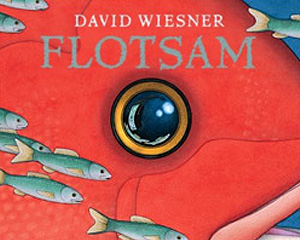
Flotsam is a children's picture book written and illustrated by David Wiesner. Published by Clarion/Houghton Mifflin in 2006, it was the 2007 winner of the Caldecott Medal; the third win for David Wiesner. The book contains illustrations of underwater life with no text to accompany them.
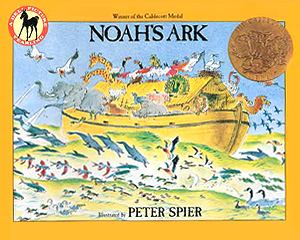
Noah's Ark is a picture book written and illustrated by Peter Spier, first published by Doubleday in 1977. The text includes Spier's translation of "The Flood" by Jacobus Revius, a 17th-century poem telling the Bible story of Noah's Ark. According to Kirkus Reviews, the poem comprises sixty three-syllable lines such as "Pair by pair". "Without revising or even enlarging on the old story, Spier fills it in, delightfully." In a retrospective essay about the Caldecott Medal-winning books from 1976 to 1985, Barbara Bader described the book as "at once elaborate and feeble" and Revius' poem as "neither particularly suited to children nor eloquent in itself."

Tuesday, written and illustrated by David Wiesner, is a 1991 picture book published by Clarion Books. Tuesday received the 1992 Caldecott Medal for illustrations and was Wiesner's first of three Caldecott Medals that he has won during his career. Wiesner subsequently won the Caldecott Medal in 2002 for The Three Pigs, and the 2007 medal for Flotsam.

Jon Klassen is a Canadian writer and illustrator of children's books and an animator. He won both the American Caldecott Medal and the British Kate Greenaway Medal for children's book illustration, recognizing the 2012 picture book This Is Not My Hat, which he also wrote. He is the first person to win both awards for the same work.

This Is Not My Hat is a 2012 children's picture book by the author and illustrator Jon Klassen. The story is told through the unreliable narration of a little fish, who has stolen a hat from a big fish and how the big fish reacts to the theft. It is a thematic follow-up to I Want My Hat Back and was meant to be a more literal sequel until Klassen took a suggestion to change which animals were in the story. The book was well received by critics who praised its dark or ironic humor which could only be understood by comparing the words of the little fish's narration against the events of the illustrations. In addition to several positive reviews, Klassen won the 2013 Caldecott Medal and the 2014 Kate Greenaway Medal becoming the first book to win both awards. This is Not My Hat was also a commercial success.

The Emperor and the Kite, written by Jane Yolen and illustrated by Ed Young, is a 1967 picture book. The Emperor and the Kite was a Caldecott Medal Honor Book for 1968 and was Young's first Caldecott Honor Medal of a total of three during his career. Young won the Caldecott Medal in 1968 for The Emperor and the Kite, which he illustrated.
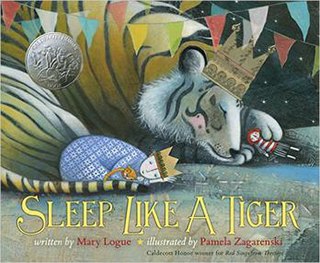
Sleep Like a Tiger, written by Mary Logue and illustrated by Pamela Zagarenski, is a 2012 picture book published by HMH Books for Young Readers. Sleep Like a Tiger was a Caldecott Medal Honor Book in 2013. Other works of Zagarenski are Red Sings from Treetops: A Year in Colors, which was also a Caldecott Medal Honor Book in 2010, and This Is Just to Say: Poems of Apology and Forgiveness, which is a 2008 Lee Bennett Hopkins Poetry Award Honor Book.



